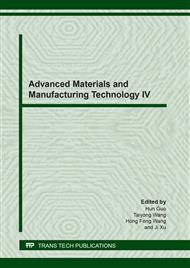[1]
Lin Tang, Bo Li, Sen Yang, Qiuli Duan, Baoyin Kang. The effect of electrolyte current density on the electrochemical machining S-03 material. Int J Adv Manuf Technol, 2014(5):1093-1098.
DOI: 10.1007/s00170-014-5617-x
Google Scholar
[2]
Sílvia, Anselmo, Cássio, Wilson. Analysis of Tool Wear, Surface Roughness and Cutting Power in the Turning Process of Compact Graphite Irons with Different Titanium Content. Journal of the Brazilian Society of Mechanical Science & Engineering, 2010(3):234-240.
DOI: 10.1590/s1678-58782010000300006
Google Scholar
[3]
W. Xu, M. Ferry and Y. Wang. Influence of alloying elements on ascast microstructure and strength of grey cast iron. Mater Sci Eng, 2005(1):326-333.
Google Scholar
[4]
Shingarwade, Harne. Effect of Reaming Process Parameters on Surface Roughness Using Taguchi Method. International Journal of Engineering Research & Technology, 2013(1):362-365.
Google Scholar
[5]
Liang X, Liu Z. Experiment investigation on effects of tool flank wear on surface integrity during orthogonal dry cutting of Ti-6Al-4V. Int J Adv Manuf Technol, 2017:17-26.
DOI: 10.1007/s00170-017-0654-x
Google Scholar
[6]
Y. Kashimura. Study on detection of drill wear and breakage (first report). Journal of the Japan Society of Precision Engineering, 1984(6): 939-942.
Google Scholar
[7]
Stefano Sartori. The influence of material properties on the tool crater wear when machining Ti6Al4V produced by Additive Manufacturing technologies. Procedia CIRP, 2016(46):588.
DOI: 10.1016/j.procir.2016.04.032
Google Scholar
[8]
BARNES S, PASHBY I R. Through-tool coolant drilling of aluminum/SiC metal matrix composite. Journal of Engineering Materials & Technology, 2010(4): 384−388.
DOI: 10.1115/1.1288925
Google Scholar
[9]
PAULO DAVIM J, MONTEIRO BAPTISTA A. Relationship between cutting force and PCD cutting tool wear in machining silicon carbide reinforced aluminum. Journal of Materials Processing Tech, 2010(3): 417−423.
DOI: 10.1016/s0924-0136(00)00495-7
Google Scholar
[10]
Y Yang, JF Li. Study on mechanism of chip formation during high-speed milling of alloy cast iron. Int J Adv Manuf Technol, 2010(1-4):43-45.
DOI: 10.1007/s00170-009-2064-1
Google Scholar
[11]
Chen Tingting, Guo Xuhong. Research on the Surface Roughness Predictive Model of Austempered Ductile Iron Based on Genetic Algorithm.Advanced Materials Research, 2012(497): 61-67.
DOI: 10.4028/www.scientific.net/amr.497.61
Google Scholar
[12]
Luan XN, Zhang S, Cai GL. Optimal cutting parameters to reduce power consumption in face milling of a cast iron alloy for environmental sustainability. Sustainable Design and Manufacturing,2016: 135-148.
DOI: 10.1007/978-3-319-32098-4_12
Google Scholar
[13]
Bezerra AA, Machado AR, Souza AM, Ezugwu EO. Effects of machining parameters when reaming aluminum-silicon (SAE322) alloy. Journal of Materials Processing Tech, 2000(2):185-198.
DOI: 10.1016/s0924-0136(01)00561-1
Google Scholar
[14]
Aharah AG, Chehassan CH, Ghazali MJ. Performance of uncoated carbide cutting tool when machining cast iron in dry cutting condition. International Journal of Modern Physics B, 2009(06n07): 1796-1802.
DOI: 10.1142/s0217979209061640
Google Scholar
[15]
X.K. Yang, Y.G. wang. Cutting performance of reaming alloy grey cast iron HT250 using carbide, cermet and CBN reamers. Key Engineering materials, 2017(764):263-264.
DOI: 10.4028/www.scientific.net/kem.764.261
Google Scholar
[16]
LIST G, NOUARI M, GÉHIN D, GOMEZ S, MANAUD J P, LE PETITCORPS Y .Wear behavior of cemented carbide tools in dry machining of aluminum alloy. Wear, 2005: 1177−1189.
DOI: 10.1016/j.wear.2005.02.056
Google Scholar
[17]
A. TASKESEN, K. KUTUKDE. Analysis and optimization of drilling parameters for tool wear and hole dimensional accuracy in B4C reinforced Al-alloy. Transactions of Nonferrous Metals Society of China, 2013:2524-2526.
DOI: 10.1016/s1003-6326(13)62764-8
Google Scholar
[18]
Balasubramanian S and Ganapathy S. Grey relational analysis to determine optimum process parameters for wire electro discharge machining (WEDM). International Journal of Engineering Science & Technology, 2011(1):95-101.
Google Scholar
[19]
PALANIKUMAR K. Experimental investigation and optimization in drilling of GFRP composites Measurement. Journal of the international Measurement Confederation,2011:2138-2148.
DOI: 10.1016/j.measurement.2011.07.023
Google Scholar
[20]
RAJMOHAN T, PALANIKUMAR K, KATHIRVEL M. Optimization of machining parameters in drilling hybrid aluminum metal matrix composites. Transactions of Nonferrous Metals Society of China, 2012: 1286−1297.
DOI: 10.1016/s1003-6326(11)61317-4
Google Scholar


